
President Trump said Tuesday the Smithsonian Institution was too narrowly focused on negative aspects of U.S. history, including “how bad slavery was.” Trump’s social media post minimizing the horrors of chattel slavery came after the White House ordered a far-reaching review of Smithsonian museum exhibitions in order to ensure they align with Trump’s interpretation of U.S. history.
In early 2020, Democracy Now! spoke with the newly appointed secretary of the Smithsonian Institution, Lonnie G. Bunch III, in Washington, D.C. Bunch was previously the founding director of the Smithsonian’s National Museum of African American History and Culture. He shares stories of the work of building the museum and its collections, and the time when President Trump made a visit during his first term. “The museum has become a pilgrimage site, a site of resistance, a site of remembering what America could be and a site to engage new generations,” said Bunch.
Transcript
AMY GOODMAN: This is Democracy Now!, democracynow.org. I’m Amy Goodman.
President Trump said Tuesday the Smithsonian Institution was too narrowly focused on negative aspects of U.S. history, including, quote, “how bad slavery was,” unquote. Trump’s social media post minimizing the horrors of chattel slavery came after the White House ordered a far-reaching review of Smithsonian museum exhibitions in order to ensure they align with Trump’s interpretation of U.S. history.
In July, the Smithsonian’s National Museum of American History removed references to President Trump’s two impeachments from an exhibit. The Washington Post reports the change occurred during a content review done under pressure from the White House to remove an art museum director. The references were restored earlier this month, though with changes to the prior text.
In a letter to the secretary of the Smithsonian, Lonnie Bunch, the White House writes that the first museums to be reviewed would include the National Museums of American History, of African American History and Culture, the National Museum of the American Indian, among several others.
Well, in early 2020, just before the pandemic, I had the opportunity to sit down with Lonnie Bunch at Busboys and Poets in Washington, D.C., on the occasion of his release of his new book, A Fool’s Errand: Creating the National Museum of African American History and Culture in the Age of Bush, Obama, and Trump.
AMY GOODMAN: Ladies and gentlemen, I present to you the 14th secretary of the Smithsonian.
LONNIE BUNCH III: Miracles do happen.
AMY GOODMAN: So, how does it feel, Lonnie Bunch III, to be the first African American head of the Smithsonian and the first historian leading the Smithsonian?
LONNIE BUNCH III: I think that, for me, being the head of the Smithsonian is my way of thanking Frederick Douglass. In the 19th century, Frederick Douglass was denied the opportunity to speak at the Smithsonian by the secretary of the Smithsonian. So, when I became secretary, the first thought of my mind was: “Way to go, Fred.”
AMY GOODMAN: Wait, wait. You have to tell that story. What actually happened?
LONNIE BUNCH III: So, Frederick Douglass was going to speak, and to speak about abolitionism, and the secretary of the Smithsonian said, “We do not want anybody Black speaking at the Smithsonian.” And Frederick Douglass never spoke there. So, for me, this is about saying this isn’t the same old Smithsonian anymore.
AMY GOODMAN: So, talk about the location of the museum and the battle you fought. You almost resigned over this.
LONNIE BUNCH III: Yeah. Normally, Congress tells the Smithsonian, “Put a building here.” In this case, there was a concern that this would be the last spot on the Mall. And many people were concerned that, you know, “Should that be an African American Museum?” And there were other spots that they wanted the museum to be, places I still can’t find. I don’t know where the hell they were. But the notion was, you had to make an argument where the museum should be, and let’s convince the regents and Congress. So, I made this argument that, you know, the Mall is where the world comes to understand what it means to be an American, and that means that story is incomplete. Look at those white buildings. Something’s missing. And I said the museum needs to be on the Mall.
But I realized that I didn’t have any control over that. So, I remember working with Kinshasha Holman Conwill, who was my deputy, who was just brilliant — please, clap for her, because she did so much work. And so, we brought in some consultants about crisis management, in case we didn’t get the answer we wanted. And we figured, “Who knew crisis management? Clinton.” So we called Clinton people. And they said to me, “What are you going to do if you get a spot in the middle of nowhere that’s horrible?” And I wasn’t sure what to do. And they said, “Oh, we know what you’re going to do. You’re going to walk. You’re going to quit.” So, I knew that if we didn’t get the spot I wanted, I was going to have to quit, because I could not let them use me to put Black culture in the corner, in the back, in the dark. But I must admit, when the Smithsonian said, “You’ll be where we are, on the corner of 14th and 15th and Constitution,” all I could think about was: “The 14th and 15th Amendment. Here we come.”
One of the most important things for me was to talk about the slave trade. And I had been in museums that made — you know, recreated slave trade. And I’m not going to be critical of it, but I hated that stuff. So, I felt that we had to find real remnants of a slave ship. And so, I talked to people like James Early, many of my friends. And we realized that we had to basically map the ocean floor, because that’s where most of the ships were. And we spent two years — James, you remember — going to Cuba, negotiating with everybody to allow us to dive for a slave ship that sank off the coast of Matanzas, which is 60 miles east of Havana. And we couldn’t get permission to do it.
Then I got lucky. I had taught every summer in the ’90s in South Africa. I met a lot of people, talked and taught on Robben Island. And one of my former students called —
AMY GOODMAN: You met Nelson Mandela.
LONNIE BUNCH III: I met Nelson Mandela with James Early. You know, nothing happens if you’re not with James Early. And so — but what this student said is, “Could you bring the resources to help find a ship?” And we did. We found the São José. It was a ship that left Lisbon in 1794, went all the way to Mozambique and picked up 512 people from the Makua tribe, was on its way back to the New World when it sank off the coast of Cape Town. Half of the people were lost. The other half were rescued and sold the next day, so we have no idea about them.
But I felt really obligated to go back and talk to the Makua people. So I went to Mozambique and met with the chief of the Makua people. And he said to me, “I want to give you a gift.” And he gave me a vessel, a bowl that was wrapped in cowrie shells. And when I opened it, it was full of dirt. And I’m trying to figure out the gift. And then he said, his ancestors have begged me “to take this soil, take it back to the site of the wreck, sprinkle it over the site of the wreck, so for the first time since 1794 my people can sleep in their own land.” That’s what we did.
AMY GOODMAN: Can you talk about the collections inside?
LONNIE BUNCH III: Well, you know, one of the challenges is not having anything to begin with. And the truth is, we thought about: Should this be a museum driven by technology? But it’s the Smithsonian. You go to see the ruby slipper, the Greensboro lunch counter, some airplane, and that — I should say it differently, the Wright Flyer or the Vin Fiz. I’m now secretary of the whole thing. I got to remember that.
But I think what’s important is that we had to build collections. And I wasn’t sure how we could do it. We didn’t have a lot of money. And so, one night, I had come home from work late, and I fell asleep in front of the television. And I woke up, and there was something called Antique Roadshow. I had never heard of it. And I thought, “What a good idea! I’ll steal it.” So, what we did is we rebranded it, “Saving African American Treasures,” and we went around the country, and we worked with local museums to preserve and conserve grandma’s old shawl or that 19th-century photograph. And then what happened is, people would then say, “Wow! We’ve got stuff. Do you want it?” And we would say, “Give most of it to the local museums.” But if it was really cool, it came back to D.C. And what will happen is, either we got things then, or people heard about us, and they called us.
And the one that I always tell is so meaningful to me. I got a call from a great collector named Charles Blockson in Philadelphia, who said he had material from Harriet Tubman. And I said, “I’m a 19th-century historian. Nobody’s got anything from Harriet Tubman. There are two tiny artifacts in her house in Auburn, New York, and that’s it.” And he said, “Look, would you at least come up and take a look?” And I respected him, but also he said he’d buy me a Philadelphia cheesesteak. So I said, “All right, I’ll come.”
So I go up, and Blockson was a big man, 6’4”, 200-pound, big man. And he came out carrying a tiny little box. And in the box, he reached in and pulled out photographs of Harriet Tubman’s funeral that I had never seen. And I said, “Oh my goodness!” And he got excited, and he punched me. It hurt. I mean, it really hurt. He pulled out 33 things, and every time he punched me. I was doing my best rope-a-dope, trying to duck. It hurt. Then he pulled out a hymnal, that had all those spirituals that Harriet Tubman would sing when she would alert the enslaved, “Steal Away to Jesus,” Swing Low, Sweet Chariot.” And there it was. And by then, I am crying. I don’t know what to do. I don’t know if it’s from the pain or the pleasure, but I’m crying.
But what really scared me was, I looked at this, and I thought, “I can’t buy — I can’t afford this. How am I going to do this?” So, I danced around. I said, “Listen, what’s it going to take for this to come to the Smithsonian?” And Dr. Blockson said, “Shake my hand.”
And it was that kind of generosity that allowed us to build the museum. We collected 40,000 artifacts, of which 70% came out of basements, trunks and attics of people’s homes. So, the museum is not a museum created by us. It’s a museum owned by a community who shared not their stuff, but their stories, their family, their history with us. And so, that’s why we felt that we could do what we had to do, because we wanted people to know we honored and trusted everything they brought forward.
AMY GOODMAN: And the title of your book is A Fool’s Errand: Creating the National Museum of African American History and Culture in the Age of Bush, Obama, and Trump. So, describe what happened in January of 2017 on Martin Luther King Day.
LONNIE BUNCH III: Well, I think it’s important to realize that the first place Donald Trump visited in an official capacity was the museum. And I think he was stunned by the stories we told, and there was so much he didn’t know. And I think what really — OK, don’t laugh too long. But what I’ve learned is that there’s so much in the museum most people don’t know. OK, let me try to be diplomatic on that one. But the reality is that what I realized is that if people who didn’t know but had political influence could come through the museum, I could help them understand, hopefully, something that would change the way they did it. You can’t change everybody. OK, I know that. But it was really important to me to make sure that the political community came into the museum.
And so, I was really pleased with the fact that, from that moment on, even before that, the public came in waves, overwhelming numbers. I mean, think about — for me, what is powerful about the museum is we expected 4,000 people a day, we got 8,000 people a day. We ended up having the most diversely visited audience of any museum in the world. In the world. And what is so powerful to me is 30% of the people who came into the museum in the first two years had never been in another museum in their lives. People talk about how they’re able to sort of — grandparents sharing with great-grand — with grandchildren.
But to me, the most amazing moment — there are many of them — was there was a mother taking her daughter through — taking her son through, and she was talking about Medgar Evers, standing in front of our discussion of the great civil rights leader who was murdered in 1963, and she told his story. And after she finished, another woman came over to her and said, “I want to thank you for telling that story.” And the mother was a little — you know, “Why?” And the woman said, “Because Medgar Evers was my father.”
That kind of thing happens over and over and over again in the museum. There are people who cross all kinds of lines, share all kinds of stories, to recognize that in the era of Donald Trump, the museum has become a pilgrimage site, a site of resistance, a site of remembering what America could be, and a site to engage new generations to recognize they have an obligation to make a country live up to its stated ideals.
AMY GOODMAN: Going back to that visit of President Trump —
LONNIE BUNCH III: I’ve left that visit of President Trump.
AMY GOODMAN: You took him to the area in the museum that talks about the Dutch and the slave trade? Do you remember this moment?
LONNIE BUNCH III: I’m a historian. I remember every moment.
AMY GOODMAN: Share that story with us.
LONNIE BUNCH III: Well, no, I think it’s important that when Donald Trump came through the museum, as I say in the book, we were talking about slavery, and he mentioned that, in some ways, as I — he was looking at the piece on the Netherlands and the Dutch, and I thought, “You know, he’s starting to engage. This is really great.” And he turned around, and he said that “they love me in the Netherlands.”
And what I realized is, that’s why we needed the museum, that the museum has to help people understand that, though they may love you, the reality is the story is deeper, richer, more painful and more profound. And I must admit, by the end of the tour, he began to engage more. So, it taught me that that museum can engage anybody, everybody, to learn these stories.
AMY GOODMAN: Lonnie, you write in your book that few could comprehend how dramatically the mood of the country would be altered by the election of Donald Trump just months after the dedication of the museum. His selection changed the atmosphere in Washington and throughout the nation, and whether intentionally or not, Trump’s presidency gave voice to a conservative agenda that encouraged, or at least made visible, the hatred in the far-right groups that had been underground or laid dormant in recent years.
LONNIE BUNCH III: That’s not bad. I wrote that, huh? Not bad. OK. I mean, I think that, look, the reality is that, as a historian, I believe that the most important thing this museum can do is create new generations of activists, is really to say, “Here is a history that tells you what happens when people come together, sacrifice, fight for the greater good, to change a country.” It tells you how much the struggle is still in front of us. But most importantly, it says, “If you sit and simply complain, all you’re doing is sitting and complaining. But if you organize, if you strategize, if you plan, if you vote, you have an opportunity to help a country be what we want it to be, a country that supposedly lives up to its ideals.” It never has, but that’s our challenge to demand that.
AMY GOODMAN: You talk about what happened in Charlottesville, the horror there of the white supremacist march, and then what happened the day before, right outside of your museum.
LONNIE BUNCH III: So, there was a — a woman was an Uber driver, was taking some people who were these white supremacists. They had come to Washington. And they were driving past the museum, and they started making comments about the N— museum, what a horrible place. And this woman stopped the car, said, “You cannot disrespect our museum,” and kicked them out, right in front of the museum. Although I wish I had known, because I would have come out and said, “Come on in. The water’s fine.”
But I think the point to me was, the museum, within a few months, had already become that symbol, symbol for those that hate, but a symbol of possibility for those that don’t. And as you know, one of the challenges of building a museum, the museum was considered the Smithsonian museum most at risk for domestic terrorism. So, really, my biggest concern was security, making sure the visitors, the staff and the collections were protected. And the good news is, people rally around us time and time again.
AMY GOODMAN: Can you describe what happened with the noose?
LONNIE BUNCH III: So, about a year later, we have a, in the museum, discussion of segregation. We talk about the Klan. And there’s amazing footage of the Klan marching in Washington in 1924, 1925. And the interesting part for me is, where they take a break is where we built the museum. So, gotcha. So I wanted, you know, that sense of understanding that story.
But one day, the security called me. Somebody left a noose on the floor. And it was really one of the most painful moments. Now, it’s interesting. For me, it didn’t surprise me. I expected that. But for many of my younger staff, they were unbelievably angry, unbelievably afraid, unbelievably mad. How could this happen at the Smithsonian?
I was in a meeting afterwards, and all of a sudden people said, “Would you come out to the front of the museum?” There, for the first time, hundreds of people from other Smithsonian museums marched across the Mall in solidarity with this museum. And there were people who brought flowers just to put in front of the museum, as if to counter the pain and the curse of that.
And it taught me something. I had never seen the Smithsonian come together like that, and I had also realized that no action of hate or terror would undermine what we accomplished. In fact, what we accomplish would illuminate that hate and the terror in a way that those that hate wouldn’t want to — wouldn’t want it to be understood. So, that was a really dark day, but the way people responded made it one of the days I’ll never forget.
AMY GOODMAN: Lonnie Bunch, secretary of the Smithsonian, in a February 2020 interview. The Smithsonian Institution is the world’s largest museum, education and research complex, with 21 museums, 14 education and research centers and the National Zoo. He was also the founding director of the National Museum of African American History and Culture. I interviewed him at Busboys and Poets in Washington, D.C., on the occasion of the release of his book, A Fool’s Errand: Creating the National Museum of African American History and Culture in the Age of Bush, Obama, and Trump. It was February 2020, shortly before the start of the pandemic. Earlier this week, President Trump said the Smithsonian Institution was too narrowly focused on the negative aspects of U.S. history, including, quote, “how bad slavery was.”
That does it for the show. To see the whole interview with Lonnie Bunch, you can go to democracynow.org. I’ll be back at Busboys and Poets September 7th interviewing Andy Shallal. I’m Amy Goodman. Thanks for joining us.

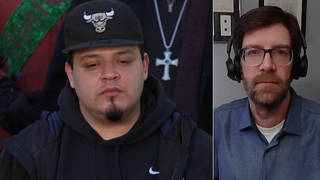

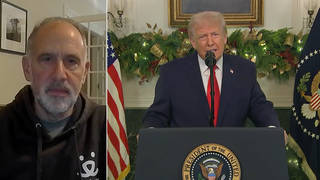
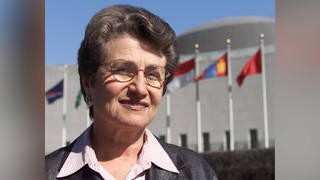
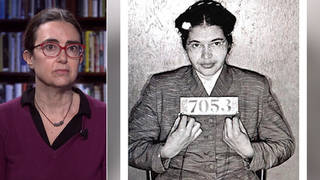
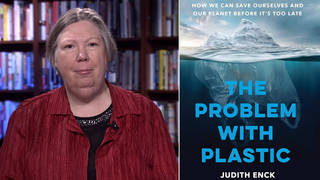

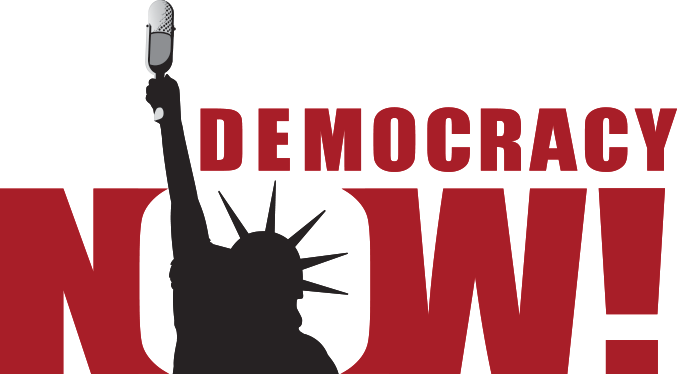
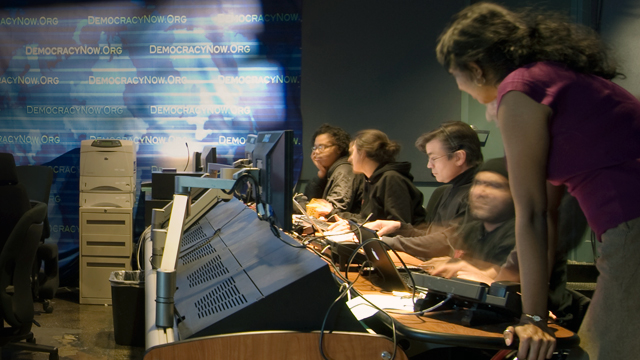

Media Options